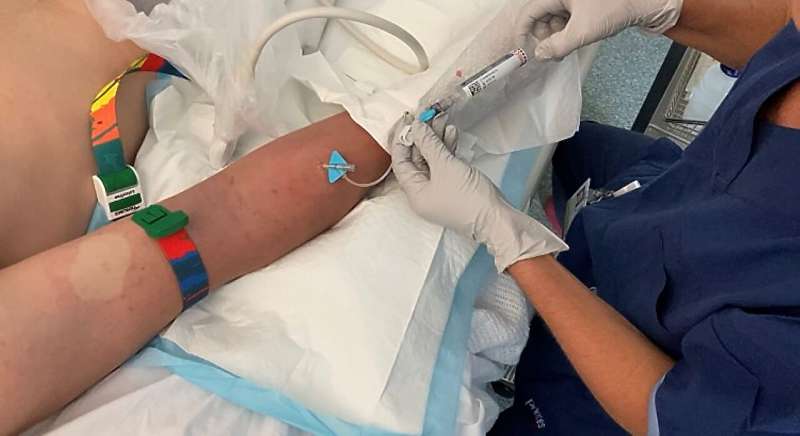This article has been reviewed according to Science X's editorial process and policies. Editors have highlighted the following attributes while ensuring the content's credibility:
fact-checked
peer-reviewed publication
trusted source
proofread
Study identifies optimal catheter for pediatric IV medication administration

Hope is on the horizon for sick children requiring intravenous canulation to administer medication. A Griffith University–led randomized controlled trial has provided evidence about the most effective type of catheter to use.
Led by Griffith University Ph.D. student Tricia Kleidon, the study has recently been published in JAMA Pediatrics and compares peripheral intravenous catheters (which are short, thin tubes inserted into the upper and lower limbs), and midline catheters (which are a longer alternative and are inserted in an upper arm vein with the catheter tip ending just before the axillar or shoulder joint where there is increased blood flow). It is titled "Midline compared with peripheral intravenous catheters for therapy of four days or longer in pediatric patients: A randomized clinical trial."
Professor Amanda Ullman from Griffith's Center of Research Excellence in Wiser Wound Care said PIVCs frequently fail during treatment causing therapy interruption, pain, re-catheterization, and additional health care costs.
"Midline catheters may improve functional dwell and reduce failure compared to traditional peripheral intravenous catheters," Ullman said.
"The randomized clinical trial found midline catheters failed significantly less often than peripheral intravenous catheters did.
"For children who received a peripheral intravenous catheter, 46% of them had catheters that failed, compared with only 16% of failures for children receiving midline catheters."
The study also discovered midline catheters were associated with fewer insertion attempts, increased dwell time, and lower health care costs. Importantly, both patients and parents were more satisfied with them.
Kleidon said when your patient is a sick child, reducing their pain and anxiety is paramount.
"This study shows that in the future, when children are admitted to hospital, they are likely to experience fewer needlesticks and are more likely to receive uninterrupted treatment which means they're more likely to be discharged on time," she said.
The randomized clinical trial was conducted from July 2020 to May 2022 and involved 128 patients from the Queensland Children's Hospital.
Patients who participated were aged between 1 and 18 years of age requiring peripherally compatible intravenous therapy for four days or longer.
More information: Tricia M. Kleidon et al, Midline Compared With Peripheral Intravenous Catheters for Therapy of 4 Days or Longer in Pediatric Patients, JAMA Pediatrics (2023). DOI: 10.1001/jamapediatrics.2023.3526

















